
VOICE Home Page: http://www.os2voice.org
[Newsletter Index]
[Previous Page] [Next Page]
[Feature Index]

VOICE Home Page: http://www.os2voice.org |
December 2002
[Newsletter Index]
|
| By Menno Willemse© December 2002 |
Warpstock is one of the premier OS/2 events that is organized every year. There are two events: The one in America is usually organised first, with Europe following behind a few weeks later. This year, I attended the Europe event, which was from 8 till 10 november in Arnhem. The event was held in Youth Hostel Alteveer, between the Autumn-coloured trees. Attendance was good, I suppose: there were about 150 to 180 people in the place at any one time.
I'll give you an idea of what was discussed in the lectures that I went to, and maybe some of the other things that happened.
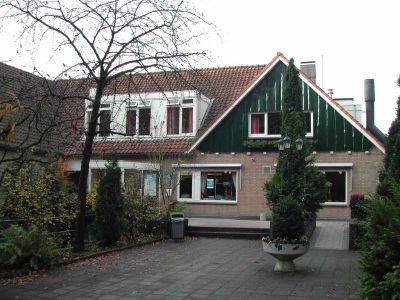
Just having returned from England at 2:30am, I was a bit late for the first few sessions. I therefore missed the gala opening and associated festivities. I floated in just in time for lunch.
After chatting a bit to someone on the finer points of TCP/IP routing, I settled down to the first session.
This was a demonstration of the new installer by the Mensys team. David van Enckevort told us a bit about the background of the work being done on the installer. One of the main points of the installer is that it is multilingual. If you prefer to install eCS in French or Italian, you can now do so. Another important part of the installation is the registration process. You were actually never meant to type in the registration key, but to read it from a file. I've never done it otherwise. You won't catch me typing in a load of weird characters if I can help it! It is important to note that the whole installation is done by IBM's CID process, and that the whole user interface to the installer creates the CID response file. You can keep this file and feed it to the installer next time you install your machine. This saves you from typing in the choices you made back then.
After this talk, Roderick Klein took over and actually showed us how the installer works. It looks very easy to use and simple. All the components of OS/2 are now configured from the same program, including networking and selection of the components. Alessandro Cantatore is working on a way to make this process re-invokable so that you can later add things that you didn't install first time round. Another improvement is that there is now a simplified LVM interface that allows you to create the logical volumes needed to install OS/2 on your system.
All in all, this was an interesting talk and I'm sure that this installer will please the new OS/2 users. It's a difference between night and day when compared to the first eCS installer.
I was a bit late for this lecture, so I missed a bit of the beginning. Oliver was showing people the infrared support drivers available for OS/2. This allows your OS/2 box to talk to devices such as IR-equipped telephones. Apparently, telephones are highly controllable through their IR ports. You can even use them as modems. Another killer app of course is having your laptop talk to other laptops through their IR interface. The IR interface is treated like a network interface. There used to be boxes with an IR port on one end an an Ethernet interface on the other, but these are now very rare. Using the IR interface, you can also print on IR equipped printers. I've seen these here and there on my travels. Basically in this case, you treat your IR interface like a standard serial port and use the driver to the printer you are using.
Oliver also demonstrated some applications that take advantage of these drivers. One was a phone book application that lets you enter phone numbers, store them in the phone and also lets you send SMS messages.
I'd been playing with these drivers, and they had a nasty tendency to trap my machine on boot. Maybe I'll try again with a fresh copy of the drivers.
When the IR session finished, Oliver continued with a talk on Virtual PC for OS/2. This is an application I'm sure I will buy at some point. Oliver started by explaining how VPC would be helpful in migrating away from OS/2. Given the fact that these people here are absolute OS/2 die-hards, I think that this was ill-advised. This part of the presentation was navigated with only a few nasty remarks, and it then became interesting.
VPC is basically a second PC inside your PC, on which you can run another operating system while OS/2 remains active. The OS/2 machine is called the "Host", while the PC running inside the host is called the "guest". Those clever folks at Connectix and Innotek have now optimised this to such an extent that performance of the guest OS is at about 90% of what it would have been if it had been running directly on the host. This is very impressive for an emulator. Most don't manage anything above say 60%. There is, however, a significant performance hit on disk I/O.
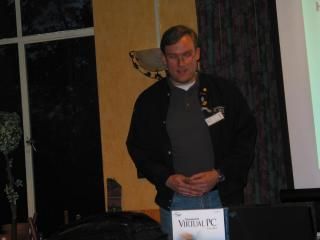
The guest PC has always the same specifications. The CPU is the same as the one in the host machine, there is an Intel Ethernet card, an S3 video card, Intel disk controller and so on. This will practically never change, so you don't have to scour the Internet for drivers once you have them.
There's three modes of networking: First, no networking. This is easy enough. Second, the Virtual NAT router. This means that the guest OS gets a virtual gateway outside, but can't be reached from there. This is useful if you have client applications running in your guest PC. The third implements a virtual switch. In this case, the guest PC is visible from outside.
Disks are emulated as well. This is done in large 2GB files. This makes deploying guest OSes childishly simple: Just copy the associated files to another machine and point VPC at them. It will always work because all the virtual PCs have exactly the same configuration.
One feature will make VPC the darling of all beta testers: The undo feature. It works like this: You start with a clean install and save the file to your host PC. Then, you install the application that you want to test. If this application buggers up your installation, you can then close the virtual PC and throw away all the changes made since your last save, giving you your fresh install back.
All this was duly demonstrated by Oliver, and this brought the lectures for this day to a close.
After the lectures, I found myself talking to Roderick and Kim Cheung. Dinner was apparently on reservation and I hadn't reserved. Me, David, Roderick and Kim Cheung set off in Joachim's car to find some place to eat. We parked in a not-yet-completed garage and settled down in a Dutch restaurant, where they serve an excellent mixed grill. Upon returning to the youth hostel, Joachim driving and Roderick navigating, we saw an internet kiosk PC. Closer inspection revealed it to be a Windows 98 box. Roderick immediately set about trying to crash it, but the strange effects may just have been the design.
After a few drinks and a highly instructive MP3 movie about IP routing, I decided to call it a night. I have been put in a room, supposedly with others, but they have not arrived yet. Oh well... First one asleep doesn't hear the rest snore.
Next morning, I rose bright and early (OK 8:30am). Went to breakfast. Chatted with some people a bit. then went to the first lecture.
UpdCD was basically created when Zsolt got tired of redoing fixpaks whenever a box needed installing. The idea is simple: Make a copy of the installation media onto your hard disk, replace all the files with those from the fixpaks and burn the result back onto a fresh installation CD. While he was at it, he also added support for including your own products and replacing the buttons with other, nicer buttons.
To make this procedure easier, Zsolt created a GUI front end that kicks off the file copies, creates the ISO image of the new installation CD and burns this image onto the CD. Supported versions of OS/2 are Warp 3, Warp 4, Warp Server for e-Business, all the Convenience packages and eComStation. All in all, if you install your PC often, this is a very worthwhile addition to the toolbox.
Webpage: http://xenia.sote.hu/~kadzsol/rexx/sajat/updcd.htm
When I first saw Maul Publisher at Warpstock 2001, I thought it looked nice. Today, Maul is bloody impressive! I saw Peter create very nice colourful documents on a not-very-fast PC. I picked up a demo CD of Maul, and have been playing with it for a while. Most of Peter's presentation consisted of demonstration. First, a document consists of pages, in which you have frames. The frames are the objects that contain the actual visual elements. Maul employs the concept of "frame handlers". A frame handler's job is to draw some visible element into a frame. The first frame handler that comes to mind is, of course, text. Another frame handler can draw a background, such as a crosshatch pattern, a gradient fill or some such. Other handlers include bitmaps, and metafiles. Handlers also exist for drawing the border of a frame. It's possible to have, for instance, text running along the border of your frame. All in all, Maul offers a dazzling number of tools to play with. It's certainly an asset to the OS/2 platform.
Webpage: http://www.manglais.com/
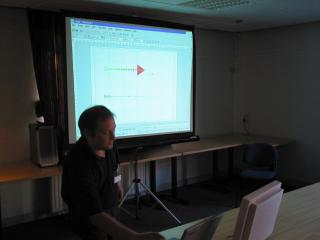
There are always people who think they can do better than IBM at implementing some feature of the operating system. Sometimes, they are even right! In this case, John Gow has rewritten the way in which streaming media such as sound or video data travels between source and destination through the kernel.
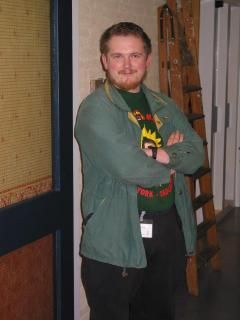
DTA uses the client-server concept. A server communicates directly with the hardware and executes in kernel-space (ring 0). The server sources or sinks (John's terms I believe) data to and from a device. So if you are reading sound data from a sound card, the DTA server is sourcing data. If you are playing the sound, the DTA server is syncing data. Client applications execute in ring 3, which means they are protected from each other at the cost of being unable to access hardware directly. The DTA core handles communication between the two.
So where does this leave current OS/2 multimedia applications? Well, for one, the DTA coexists with MMOS/2. This means that the old applications can use the (more or less) familiar MMPM calls to produce sound and video. There is also ongoing work to implement a MMPM driver that allows MMPM to use the DTA for streaming multimedia data.
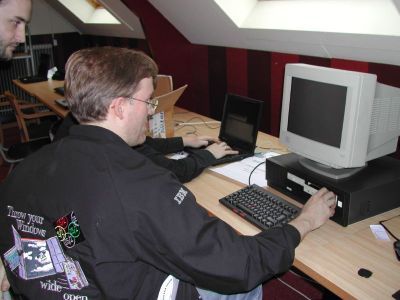
The next time slot I spent milling around the distributor's booths and the user group room. This was of course where I spotted the PC that I am now using to write this report. Another thing of note was that the new http://www.os2.org/ server was on display there. The os2.org people were able to get it cheaply because it had fallen at some point and some of the metal was bent. It still works fine, though and it's expected to be online soon at their new hosting address. It's a nice one-unit IBM e-Server x-Series machine. Long may it serve the OS/2 community.
The exhibitors there were Mensys, Norman (of antivirus fame), a German bookseller, and Bluelink, who were selling IBM Thinkpads, printers, and desktop machines. I bought Virtual PC, upgraded eComStation to 1.1 and got my little PC. This made this a very expensive weekend, as anticipated...
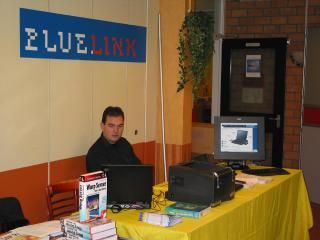
Markus Montkowski is one of those people capable of tackling the arcane arts of OS/2 device driver development. His speciality is the USB side of things. Apart from that, Markus discussed PCMCIA devices, infra-red devices, bluetooth and firewire devices as well. The first three of these are currently supported under OS/2, while the rest is being thought about.
With hot pluggable devices becoming more and more common these days, a redesign of OS/2's device handling becomes necessary. Currently, OS/2's devices are recognised at boot time and expected to stay there until shutdown. A group of people are now replacing yet another subsystem of OS/2 with one called the CNFMGR.
The config manager's design uses a generic server process that relies on a central database and DLL plugins. The idea is that a device database could be placed somewhere on the Internet and replicated to your wokrstation, presumably along with any required device driver DLLs.
This new subsystem could be very important to OS/2's future.
This concluded the lectures for Saturday. I didn't fancy the food the hostel was offering, so I went off into Arnhem and settled down in a Chinese restaurant called De Chinese Muur, and I spotted several other Warpstockers there. Back to the hostel for a few beers, then bed. I noticed we had acquired another sleeper, but I once again was the first to turn in so I didn't see him till next morning.
Rise and shine! It's Sunday! We were expected to be out of the room by 10:30, so I started by packing all my stuff together and putting it in the car. Next, breakfast. Then, I did a retake of John Gow's bit about DTA. There had been lots of questions last time, but this time John was able to carry on talking to the end.
At Netlabs, a new version of the EPM text editor can be pulled out of the Concurrent Versioning System or downloaded as a WarpIn package. People have been refurbishing EPM so that it now does syntax highlighting, macro recording, reflowing of source code, bracket matching and more. One of the nice things is that a special directory has been created in the epm structure where you can put your own enhancements without fear of disturbing anything in the Netlabs directories. This allows anyone to extend EPM even further. Furthermore, EPM will recognise what kind of file you have loaded and act accordingly. A lot has been done to this editor. Have a look!
Webpage: http://www.netlabs.org/
OS/2 has a good number of email clients available. One of these is the new Lookout/2 client. It's designed specifically to copy all the functionality of a well known email client on you-know-what. It'll do mail, todo lists, notes (as in small pieces of text, not Lotus), a calendar, and a "today" screen that combines the things to do today. Lookout is extenible, though and Bart demonstrated this with a weather plugin that gets the current weather from a server on the Internet. This way, you can see if the sun is shining outside without actually moving out of the basement.
Lookout incorporates a standard URL structure that allows modules to refer to each other's pieces of data. Everything is also programmable in REXX. For mail transfer, it supports POP, SMTP and IMAP. Lookout is designed to be multilingual. It will look at the LANG variable and come up in the appropriate language, or failing that, English.
Lookout is in the process of being released on Netlabs, so look for it there. [According to Adrian Gschwend, the first public beta is going to be released around Christmas. - Editor's note]
Drawit is a vector oriented drawing program. This makes it the right tool for drawing charts or line drawings. It can provide large amounts of graphical fioreworks such as gradients, fountain fills and more. You can also add bitmaps, though Drawit does not do very much with them except display them. I'm looking to replace the venerable program PM Chart, and this may just be the next thing. I only wish I could export to other file formats such as DXF. I need to exchange data occasionally with other programs and a common file format would be most helpful.
Drawit can be found at Hobbes: http://hobbes.nmsu.edu
After that, there was a round of thanks for all the organising persons and that, more or less, was that. Another Warpstock done.
I liked this convention. It was pleasantly busy. The sessions were good. One of the striking things was the number of prople working on extending the system. People like Daniela Engert, Markus Montkowski, John Gow, the people of Team OS/2. It's good to know that people like this exist and care enough about OS/2 to devote large parts of their free time to develop software for others, often for free.
IBM was supposed to show up in the person of Oliver Mark, but he didn't arrive due to personal circumstances. The presentation is on the Warpstock CD. It lists all the things IBM has done on OS/2 lately. Rather a lot of drivers. Getting OS/2 supported on some of their later ThinkPad models. It may be true that IBM management wants to discontinue support for OS/2, but until that happens, IBMers are still devoted to delivering quality products. And we need all of them!
See you next year. Don't know where yet, so keep your ear to the ground. Until then, keep 'em running, keep 'em rolling!
References:
|
[Feature Index]
editor@os2voice.org
[Previous Page] [Newsletter Index] [Next Page]
VOICE Home Page: http://www.os2voice.org